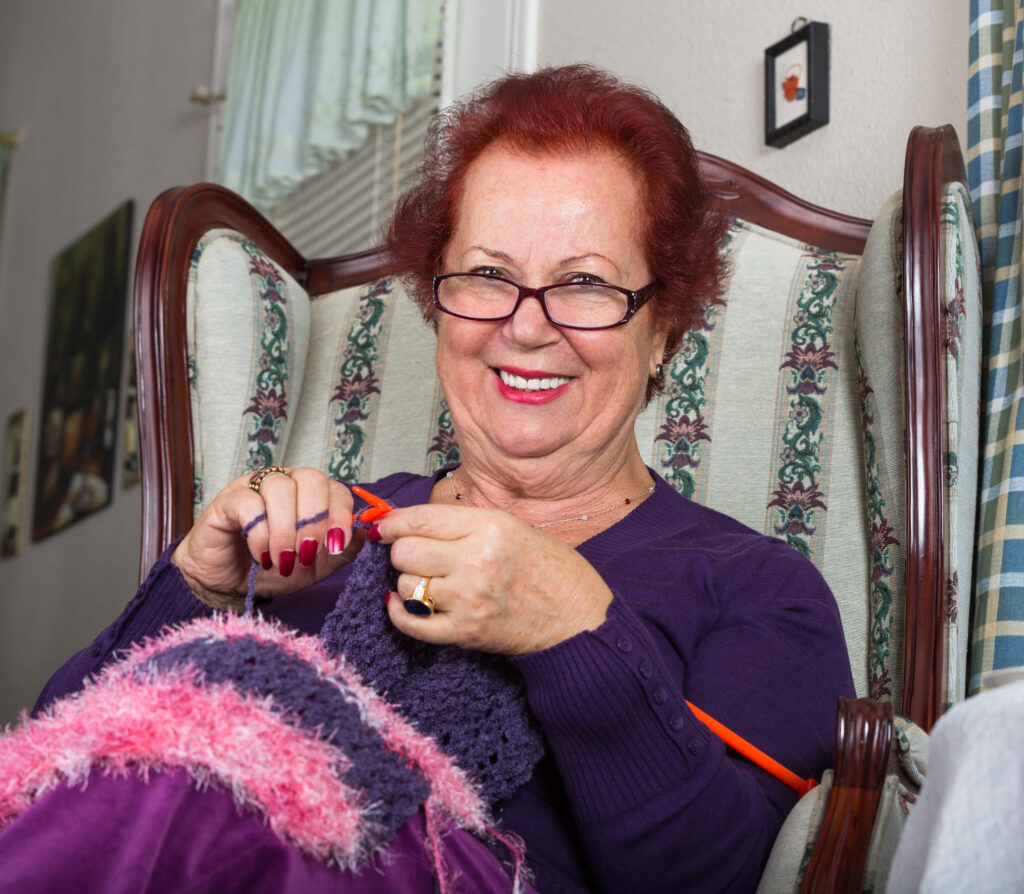
“Crafters have this expression that yarn is cheaper than therapy,” said Hallie Lucero, MS, OTR/L, Lifespark Home Health Occupational Therapist, “but I absolutely believe that yarn is therapy!” In occupational therapy (OT), crafts are traditionally used to work on client goals, she said, adding that the roots of OT are in the psychiatric world when women were recruited to teach crafting and vocational skills to soldiers wounded in WWI. The profession expanded during WWII when military hospitals recognized the need to help soldiers with psychiatric and orthopedic conditions regain their independence and sense of purpose.
With the signing of the Community Mental Health Act in 1963, OT services shifted from the hospital to the community, broadening its focus to address not just physical abilities, but also mental, emotional, social, and economic well-being.
The Yarn Connection
When Hallie arrived at Jean’s* home to do an OT evaluation for Medicare home health services, she knew immediately they had something special in common. “Her living room was lined with baskets and baskets of beautiful yarn,” she said. “I’m a knitter and I love meeting other knitters, so I asked if she was working on a project, expecting her to say something about knitting sweaters for her grandkids.”
Not this knitter. Jean, age 85, opened up a basket full of tiny hand-knit zoo animals that Hallie described as intricate, realistic, and exquisitely done. “I’ve tried knitting animals using simpler patterns and thicker yarn, and it’s really hard,” she said. “What she was doing was master-level knitting.”
When Jean saw that Hallie was genuinely interested, she revealed her true passion: tiny, intricately knitted zombies, with scars and bandages, detachable limbs and removable organs all connected by tiny pieces of Velcro for quick and easy dismemberment. “My favorite had a removable stomach with intestines that spilled out of the cavity,” Hallie said, adding that Jean’s zombies had won numerous Blue Ribbons at the Minnesota State Fair.
However, over the past several months, increasing low back pain had made it too painful for Jean to sit or stand or do much of anything, including knitting or cooking. Finally, she asked her doctor for a referral for home health services. “She told me that one of her main motivations for therapy is to get back to knitting,” Hallie said.
Pain as A Smoke Alarm
When Hallie works with clients like Jean, she teaches principles of ergonomics—the importance of healthy posture and switching positions—and knowing when to back off and when to push through.
“Pain management is a complex area of therapy,” Hallie said. “You don’t want a client to over-extend themselves, but at the same time, you also don’t want them to become fearful of causing pain or they run the risk of becoming weaker, stiffer, and less involved in their lives.”
An analogy that Hallie heard recently is to think of pain as a smoke alarm. “Just because it goes off doesn’t automatically mean there’s an emergency; check it out but don’t immediately call the fire department,” she said. “Likewise, you shouldn’t necessarily quit all activities just because you’re having a little pain, or it could make the situation worse.”
The Value of Leisure Skills
Hallie says she always enjoys working with clients who have strong leisure skills. “The occupations of life tend to be greatly undervalued, yet they’re so meaningful and health promoting, especially for people with a chronic illness or injury,” she said.
Just as the military discovered with wounded soldiers, engaging in leisure skills has been shown to reduce stress and improve mental health. In a 2007 study conducted by Harvard Medical School’s Mind and Body Institute, knitting was found to lower the heart rate by an average of 11 beats per minute and help induce a state of calm similar to that of yoga.
In addition, a 2011 study by the Mayo Clinic of people ages 70 and older found that those who knit had a lower chance of developing mild cognitive impairment and memory loss. That doesn’t surprise Hallie who said that knitting can be a complex mental exercise involving a fair amount of memorization and concentration.
The Perk of In-home OT
“Meeting with Jean in her own home, surrounded by her knitted zombies and zoo animals, is one of the luxuries of in home care over other settings,” Hallie said. “In the acute-care environment, there just isn’t time to get to know the client, to hear about their life experiences, their passions, and what matters to them most.”
For Hallie, that’s one of the best perks of her job. That, and the chance to connect with other crafters.
To learn more about our Medicare-covered skilled nursing services, visit Lifespark Skilled Home Health or call 952-345-8770.
*Not her real name. Client requested her story be shared but not her name.


